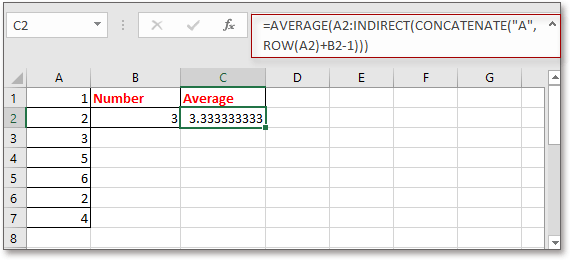Como definir um intervalo com base no valor de outra célula no Excel?
Calcular um intervalo de valores é fácil para a maioria dos usuários do Excel, mas você já tentou calcular um intervalo de valores com base no número em uma célula específica? Por exemplo, há uma coluna de valores na coluna A, e quero calcular o número de valores na coluna A com base no valor em B2, o que significa que, se for 4 em B2, vou calcular a média dos primeiros 4 valores na coluna A, conforme mostrado na captura de tela abaixo. Agora, apresento uma fórmula simples para definir rapidamente um intervalo com base no valor de outra célula no Excel.
Definir intervalo com base no valor da célula
 Definir intervalo com base no valor da célula
Definir intervalo com base no valor da célula
Para fazer cálculos em um intervalo com base no valor de outra célula, você pode usar uma fórmula simples.
Selecione uma célula em branco onde você colocará o resultado, insira esta fórmula =AVERAGE(A1:INDIRECT(CONCATENATE("A",B2))), e pressione Enter para obter o resultado.
1. Na fórmula, A1 é a primeira célula na coluna que você deseja calcular, A é a coluna que você está calculando, B2 é a célula na qual você baseia o cálculo. Você pode alterar essas referências conforme necessário.
2. Se você deseja fazer um total, pode usar esta fórmula =SUM(A1:INDIRECT(CONCATENATE("A",B2))).
3. Se o primeiro dado que você deseja definir não estiver na primeira linha do Excel, por exemplo, na célula A2, você pode usar a fórmula assim: =AVERAGE(A2:INDIRECT(CONCATENATE("A",ROW(A2)+B2-1))).
Contagem/Soma rápida de células por cor de fundo ou formato no Excel |
Em alguns casos, você pode ter um intervalo de células com várias cores e o que deseja é contar/somar valores com base na mesma cor. Como você pode calcular rapidamente? Com o Kutools para ExcelContar por Cor, você pode fazer rapidamente vários cálculos por cor e também gerar um relatório do resultado calculado. Baixe o Kutools e experimente hoje mesmo! |
Kutools para Excel - Potencialize o Excel com mais de 300 ferramentas essenciais. Aproveite recursos de IA permanentemente gratuitos! Obtenha Agora |
Melhores Ferramentas de Produtividade para Office
Impulsione suas habilidades no Excel com Kutools para Excel e experimente uma eficiência incomparável. Kutools para Excel oferece mais de300 recursos avançados para aumentar a produtividade e economizar tempo. Clique aqui para acessar o recurso que você mais precisa...
Office Tab traz interface com abas para o Office e facilita muito seu trabalho
- Habilite edição e leitura por abas no Word, Excel, PowerPoint, Publisher, Access, Visio e Project.
- Abra e crie múltiplos documentos em novas abas de uma mesma janela, em vez de em novas janelas.
- Aumente sua produtividade em50% e economize centenas de cliques todos os dias!
Todos os complementos Kutools. Um instalador
O pacote Kutools for Office reúne complementos para Excel, Word, Outlook & PowerPoint, além do Office Tab Pro, sendo ideal para equipes que trabalham em vários aplicativos do Office.
- Pacote tudo-em-um — complementos para Excel, Word, Outlook & PowerPoint + Office Tab Pro
- Um instalador, uma licença — configuração em minutos (pronto para MSI)
- Trabalhe melhor em conjunto — produtividade otimizada entre os aplicativos do Office
- Avaliação completa por30 dias — sem registro e sem cartão de crédito
- Melhor custo-benefício — economize comparado à compra individual de add-ins